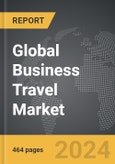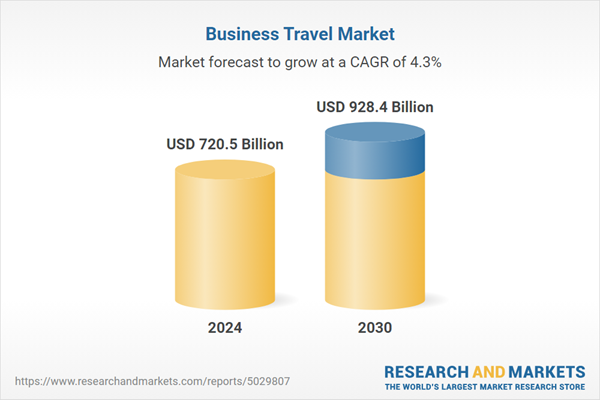The global market for Business Travel was valued at US$720.5 Billion in 2024 and is projected to reach US$928.4 Billion by 2030, growing at a CAGR of 4.3% from 2024 to 2030. This comprehensive report provides an in-depth analysis of market trends, drivers, and forecasts, helping you make informed business decisions. The report includes the most recent global tariff developments and what they mean for your business.
Segments: Service (Food & Lodging, Recreation, Transportation); Traveler (Group, Solo); End-Use (Corporate, Government).
Geographic Regions/Countries: World; USA; Canada; Japan; China; Europe; France; Germany; Italy; UK; Spain; Russia; Rest of Europe; Asia-Pacific; Australia; India; South Korea; Rest of Asia-Pacific; Latin America; Argentina; Brazil; Mexico; Rest of Latin America; Middle East; Iran; Israel; Saudi Arabia; UAE; Rest of Middle East; Africa.
The analysts continuously track trade developments worldwide, drawing insights from leading global economists and over 200 industry and policy institutions, including think tanks, trade organizations, and national economic advisory bodies. This intelligence is integrated into forecasting models to provide timely, data-driven analysis of emerging risks and opportunities.
Global Business Travel Market - Key Trends & Drivers Summarized
What Is Business Travel and How Does It Fuel Global Commerce?
Business travel, an essential component of the global economy, refers to traveling for purposes related to work or company activities. It encompasses everything from attending international conferences and client meetings to conducting site visits and participating in industry seminars. This type of travel is crucial for fostering business relationships, closing deals, and exploring new markets. Unlike leisure travel, business travel is characterized by its goal-oriented nature and often requires a higher level of service, speed, and efficiency. Companies invest in business travel to boost employee engagement, capitalize on networking opportunities, and gain competitive advantages. In an increasingly interconnected world, face-to-face interactions remain invaluable, despite the rise of digital communication tools.How Have Digital Innovations Transformed Business Travel?
The landscape of business travel has been significantly transformed by digital technology, making trips more efficient and personalized. Online booking tools, mobile apps, and integrated corporate travel management systems allow travelers and companies to plan, book, and manage travel with unprecedented ease. These technologies enable real-time updates, travel alerts, and seamless access to itineraries and tickets, which are essential for the fast-paced nature of business travel. Furthermore, advancements in mobile technology have empowered business travelers with apps that translate languages, navigate foreign cities, track expenses, and even adjust jet lag. Virtual and augmented reality are also beginning to play a role, offering potential for virtual site inspections and immersive destination previews, reducing unnecessary travel and preparation time.How Videoconferencing and Virtual Events Are Reshaping Business Travel Dynamics?
The rise of videoconferencing and virtual events has significantly impacted the landscape of business travel. As technology has advanced, tools like Zoom, Microsoft Teams, and WebEx have become more robust and widely accessible, offering rich interactive experiences that closely mimic the dynamics of in-person meetings and conferences. This shift to digital formats has led many companies to rethink their travel policies, often opting for virtual meetings as a cost-effective and time-efficient alternative to travel. The global pandemic accelerated this trend, forcing businesses to adopt remote communication strategies, which many have found to maintain productivity and even enhance work-life balance. However, while virtual events have reduced the need for frequent travel, they also underscore the value of face-to-face interactions, particularly for building relationships and handling complex negotiations. As a result, business travel is evolving rather than disappearing, with companies now more strategically choosing when and why to travel, balancing the immediacy and convenience of digital communication with the irreplaceable personal touch of in-person engagements.What Are the Current Trends Influencing Business Travel?
Current trends in business travel are heavily influenced by changes in workplace dynamics, traveler expectations, and sustainability concerns. The rise of the gig economy and remote work arrangements has introduced more flexibility in when and how employees travel for business. There's an increasing preference for combining business trips with leisure activities - often referred to as 'bleisure' travel - as employees seek to maximize their time spent away from home. Additionally, there is a growing awareness of the environmental impact of frequent flying, which has prompted companies to consider sustainability when arranging travel or to invest in carbon offset programs. Health and safety have also taken center stage, especially in the wake of the COVID-19 pandemic, with travelers and companies demanding higher standards of cleanliness and safety protocols from service providers.What Drives the Growth of the Business Travel Market?
The growth in the business travel market is driven by several factors, including economic globalization, technological advancements, and evolving corporate cultures. As businesses expand into new markets, face-to-face interaction with customers, partners, and employees across the globe becomes crucial. The development of faster, more efficient travel options, such as improved air travel services and high-speed rail networks, also facilitates greater business travel. Furthermore, as companies increasingly value the role of corporate culture and employee satisfaction, business travel is seen as a way to motivate and reward employees, leading to more travel opportunities. Consumer behavior has shifted towards more personalized and experience-driven travel, prompting the industry to adapt to these new preferences with tailored travel solutions and more integrated travel technology. Additionally, as more women and millennials enter the workforce, their preferences are shaping corporate travel policies towards better work-life balance and increased corporate responsibility, influencing the growth and direction of the market.Report Scope
The report analyzes the Business Travel market, presented in terms of units. The analysis covers the key segments and geographic regions outlined below.Segments: Service (Food & Lodging, Recreation, Transportation); Traveler (Group, Solo); End-Use (Corporate, Government).
Geographic Regions/Countries: World; USA; Canada; Japan; China; Europe; France; Germany; Italy; UK; Spain; Russia; Rest of Europe; Asia-Pacific; Australia; India; South Korea; Rest of Asia-Pacific; Latin America; Argentina; Brazil; Mexico; Rest of Latin America; Middle East; Iran; Israel; Saudi Arabia; UAE; Rest of Middle East; Africa.
Key Insights:
- Market Growth: Understand the significant growth trajectory of the Food & Lodging segment, which is expected to reach US$509.8 Billion by 2030 with a CAGR of a 5.0%. The Recreation segment is also set to grow at 3.9% CAGR over the analysis period.
- Regional Analysis: Gain insights into the U.S. market, valued at $256.9 Billion in 2024, and China, forecasted to grow at an impressive 6.1% CAGR to reach $59.2 Billion by 2030. Discover growth trends in other key regions, including Japan, Canada, Germany, and the Asia-Pacific.
Why You Should Buy This Report:
- Detailed Market Analysis: Access a thorough analysis of the Global Business Travel Market, covering all major geographic regions and market segments.
- Competitive Insights: Get an overview of the competitive landscape, including the market presence of major players across different geographies.
- Future Trends and Drivers: Understand the key trends and drivers shaping the future of the Global Business Travel Market.
- Actionable Insights: Benefit from actionable insights that can help you identify new revenue opportunities and make strategic business decisions.
Key Questions Answered:
- How is the Global Business Travel Market expected to evolve by 2030?
- What are the main drivers and restraints affecting the market?
- Which market segments will grow the most over the forecast period?
- How will market shares for different regions and segments change by 2030?
- Who are the leading players in the market, and what are their prospects?
Report Features:
- Comprehensive Market Data: Independent analysis of annual sales and market forecasts in US$ Million from 2024 to 2030.
- In-Depth Regional Analysis: Detailed insights into key markets, including the U.S., China, Japan, Canada, Europe, Asia-Pacific, Latin America, Middle East, and Africa.
- Company Profiles: Coverage of players such as Amadeus IT Group SA, Akcine bendrove Lietuvos pastas, ATITECH S.p.A., 1byone, Inc., ASCO Group Limited and more.
- Complimentary Updates: Receive free report updates for one year to keep you informed of the latest market developments.
Some of the 70 companies featured in this Business Travel market report include:
- Amadeus IT Group SA
- Akcine bendrove Lietuvos pastas
- ATITECH S.p.A.
- 1byone, Inc.
- ASCO Group Limited
- Airbnb Inc.
- Amber Gold Sp. z o.o.
- Affinity Group Limited
- Amira Enterprises Inc.
- Aurora Media Worldwide UK Ltd.
- APT Asia Pacific
- A…bergs DataSystem AB
- Ad Magic, Inc.
- Apricot Technologies Limited
- Aqualogy Services Company, S.A.
Tariff Impact Analysis: Key Insights for 2025
Global tariff negotiations across 180+ countries are reshaping supply chains, costs, and competitiveness. This report reflects the latest developments as of April 2025 and incorporates forward-looking insights into the market outlook.The analysts continuously track trade developments worldwide, drawing insights from leading global economists and over 200 industry and policy institutions, including think tanks, trade organizations, and national economic advisory bodies. This intelligence is integrated into forecasting models to provide timely, data-driven analysis of emerging risks and opportunities.
What’s Included in This Edition:
- Tariff-adjusted market forecasts by region and segment
- Analysis of cost and supply chain implications by sourcing and trade exposure
- Strategic insights into geographic shifts
Buyers receive a free July 2025 update with:
- Finalized tariff impacts and new trade agreement effects
- Updated projections reflecting global sourcing and cost shifts
- Expanded country-specific coverage across the industry
Table of Contents
I. METHODOLOGYII. EXECUTIVE SUMMARY2. FOCUS ON SELECT PLAYERSIII. MARKET ANALYSISCANADAITALYSPAINRUSSIAREST OF EUROPESOUTH KOREAREST OF ASIA-PACIFICARGENTINABRAZILMEXICOREST OF LATIN AMERICAIRANISRAELSAUDI ARABIAUNITED ARAB EMIRATESREST OF MIDDLE EASTIV. COMPETITION
1. MARKET OVERVIEW
3. MARKET TRENDS & DRIVERS
4. GLOBAL MARKET PERSPECTIVE
UNITED STATES
JAPAN
CHINA
EUROPE
FRANCE
GERMANY
UNITED KINGDOM
ASIA-PACIFIC
AUSTRALIA
INDIA
LATIN AMERICA
MIDDLE EAST
AFRICA
Companies Mentioned (Partial List)
A selection of companies mentioned in this report includes, but is not limited to:
- Amadeus IT Group SA
- Akcine bendrove Lietuvos pastas
- ATITECH S.p.A.
- 1byone, Inc.
- ASCO Group Limited
- Airbnb Inc.
- Amber Gold Sp. z o.o.
- Affinity Group Limited
- Amira Enterprises Inc.
- Aurora Media Worldwide UK Ltd.
- APT Asia Pacific
- A…bergs DataSystem AB
- Ad Magic, Inc.
- Apricot Technologies Limited
- Aqualogy Services Company, S.A.
Table Information
| Report Attribute | Details |
|---|---|
| No. of Pages | 464 |
| Published | April 2025 |
| Forecast Period | 2024 - 2030 |
| Estimated Market Value ( USD | $ 720.5 Billion |
| Forecasted Market Value ( USD | $ 928.4 Billion |
| Compound Annual Growth Rate | 4.3% |
| Regions Covered | Global |









